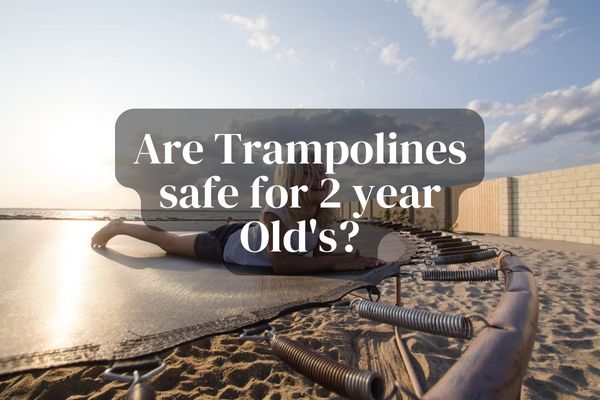Trampolines are a popular backyard activity that can provide hours of entertainment for children. However, when it comes to young children, especially 2-year-olds, parents need to take extra precautions to ensure their safety.
This article will explore developmental considerations for 2-year-olds, American Academy of Pediatrics guidelines, potential risks, and alternatives to trampolines for young children.
Developmental Considerations for 2-Year-Olds
At 2 years old, children are rapidly developing both physically and cognitively. They are gaining strength and coordination, which can lead to increased physical activity and exploration. However, they need help understanding and anticipating potential dangers fully.
Physically, 2-year-olds are learning to walk and run but may still struggle with balance and coordination. They have a higher center of gravity and may be more prone to falls and injuries. Their bones are still developing and may not be strong enough to withstand the impact of jumping on a trampoline.
Cognitively, 2-year-olds are developing their ability to understand cause and effect. They may not fully comprehend the potential consequences of their actions, which can lead to risky behavior on a trampoline.
American Academy of Pediatrics Guidelines
The American Academy of Pediatrics (AAP) recommends against the use of trampolines for children under 6 years old. This includes both recreational and competitive trampolines. The AAP cites the high risk of injury, especially to young children, as the main reason for this recommendation.
The AAP guidelines also state that trampolines should only be used with proper safety equipment, such as safety nets and padding, and under adult supervision. Even with these precautions, trampolines can still pose a significant risk to young children.
Potential Risks for 2-Year-Olds on Trampolines
Trampolines can be a fun and exciting activity for children, but they also come with a significant risk of injury, especially for young children. 2-year-olds, in particular, are at high risk of injury while jumping on a trampoline due to their developmental stage.
Lack of Coordination and Judgment
2-year-olds are still developing their motor skills and balance, which means they may lack the coordination and judgment necessary to control their movements on a trampoline. This can lead to falls, collisions with other children, and injuries.
Bone Development
Young children’s bones are not strong enough to withstand the impact of jumping, and this can lead to broken bones, sprains, and other injuries. 2-year-olds’ bones are still developing, and the impact of jumping on a trampoline can be especially dangerous for them.
Spinal Cord Injuries and Paralysis
The impact of jumping on a trampoline can also cause spinal cord injuries and paralysis, which can have lifelong consequences for young children.
What is the best age to give children a trampoline?
As a parent, it can be challenging to determine the right age to introduce your child to a trampoline. While trampolines can provide hours of fun for children, they can also pose a significant risk for injury, especially for young children.
According to the American Academy of Pediatrics, children under the age of 6 should not use trampolines. This is because children under 6 may lack the coordination and judgment necessary to properly control their movements on a trampoline. Also, their bones may not be strong enough to withstand the impact of jumping.
It is recommended to wait until the child is at least 6 years old before introducing them to trampolines. However, even at 6 years old and older, parents should still exercise caution and provide adult supervision and proper safety equipment to ensure the child’s safety during use.

Are mini trampolines safe for 2-year-olds?
As a parent, it’s natural to want to provide your child with the best tools to help them grow and develop. One such tool that has become increasingly popular in recent years is the mini trampoline, also known as a rebounder. However, many parents wonder if mini trampolines are safe for their two-year-old children to use. Let’s take a closer look at the potential risks and benefits.
From above we know that American Academy of Pediatrics advises against the use of trampolines for children under the age of six. This is because young children’s bones are still developing and are more susceptible to injury. While mini trampolines may seem like a safer option due to their smaller size, they can still pose risks to young children, particularly if used improperly.
One of the main concerns with mini trampolines for young children is the risk of falls and injuries. Two-year-olds are still developing their balance and coordination skills, which can make it challenging for them to stay upright on a bouncing surface. They may also be more prone to jumping too high or landing awkwardly, which can lead to injuries such as sprains, fractures, or even head injuries.
Another consideration is the weight limit of the mini trampoline. Many models have weight limits that are too low for parents to safely use the trampoline alongside their child. This means that young children may be using the trampoline unsupervised, which can increase the risk of injury.
It’s also worth noting that mini trampolines may not be as stable as larger trampolines, which can increase the risk of tipping or tipping over. Also, some models may not have adequate padding or protective covers, which can increase the risk of injuries from falls or collisions.
So, are mini trampolines safe for two-year-old children? The answer is not clear-cut. While some models may be designed specifically for young children and have appropriate safety features in place, it’s important for parents to carefully consider the risks and benefits before allowing their child to use a mini trampoline.
Alternatives to Trampolines for 2-Year-Olds
Given the potential risks of trampolines for young children, it’s important to explore alternatives that can provide similar benefits without the risks. Here are some alternatives to consider:
Bouncy castles
Bouncy castles can provide a similar bouncing experience as trampolines but with a lower risk of injury. They also have walls to prevent children from falling off.
Inflatable slides
These can provide a fun and safe activity for children to climb and slide down. They are also easy to set up and can be used indoors or outdoors.
Ball pits
Ball pits are a popular indoor activity that can provide a fun and safe way for children to jump and play. They also provide a sensory experience with different textures and colors.
Ride-on toys
Ride-on toys, such as balance bikes and scooters, can help young children develop their gross motor skills and coordination while also providing a fun and safe activity.
Safety Instructions before giving your child a trampoline
Conclusion
Trampolines can be a fun and exciting activity for children, but they can also pose a significant risk, especially for young children. Parents should consider the developmental considerations for 2-year-olds, the AAP guidelines, and the potential risks before allowing their child to use a trampoline.
Alternatives like bouncy castles, inflatable slides, ball pits, and ride-on toys can provide a safer alternative for young children to play and develop their motor skills. As always, adult supervision and proper safety equipment are crucial in ensuring the safety of children during playtime. Parents can help ensure their child has a fun and safe playtime experience by being aware of the risks and taking necessary precautions.
Frequently Asked Questions
What are the common injuries associated with trampolines?
Common injuries associated with trampolines include broken bones, sprains, bruises, head injuries, spinal cord injuries, and paralysis. Children can also fall off the trampoline or collide with another person, leading to further injuries.
What are the developmental considerations for young children on trampolines?
Developmental considerations for young children on trampolines include their physical and cognitive development. Children under the age of 6 may lack the coordination and judgment necessary to control their movements on a trampoline properly. Additionally, their bones may not be strong enough to withstand the impact of jumping.
What are the American Academy of Pediatrics guidelines for trampoline use by children?
The American Academy of Pediatrics recommends against the use of trampolines for children under 6 years old. Trampolines should also only be used with proper safety equipment, such as safety nets and padding, and under adult supervision.
What are some alternatives to trampolines for young children?
Alternatives to trampolines for young children include bouncy castles, inflatable slides, ball pits, and ride-on toys such as balance bikes and scooters. These alternatives provide similar benefits to trampolines while reducing the risk of injury.
Last Updated on August 25, 2023

